What's behind the Meltdown in the Commodity markets?
Commodities / CRB Index Sep 18, 2006 - 08:10 PM GMTBy: Sarah_Jones
By Gary Dorsch, Editor, Global Money Trends
“A Trend in Motion will stay in motion, until some major outside force knocks it off its course.” After climbing to a 25-year high of 365.45 on May 11 th , the Reuters Jefferies Commodities (CRB) Index began to show signs of fatigue in June and July, and then stumbled into a free-fall in August and September. With the CRB index slicing below its four-year upward sloping trend-line in early September, chart watchers would probably agree that a peak in the bullish cycle has been reached.
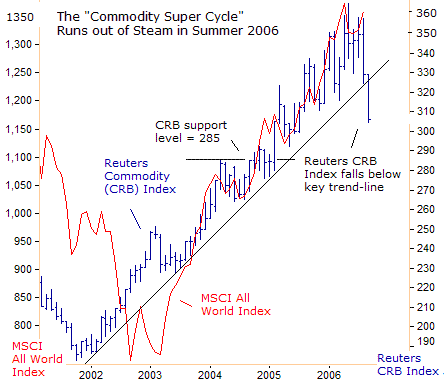
For the past five years, the Reuters CRB index closely tracked the up-trend in global stock markets. The Morgan Stanley Composite All-Country World Index reached a six-year high of 1407 on August 11 th , up 100% from its lows in October 2002, led by spectacular gains in Brazil, China, India, Korea, and Russia. On the same day, the Reuters CRB index reached a 25-year high of 365.45. Both asset classes were energized by the global economy's 5% annualized growth rate in Q'2 2006, its best performance in 30-years. At its peak frenzy, traders figured that worldwide demand would soon outstrip the worldwide supply for key industrial commodities, such as crude oil, copper, iron ore, nickel, and zinc. Over the past five years, Chinese demand for steel has grown by around 19% a year, for aluminum and copper it rose 16%, and imports of zinc soared to a record high of 860,000 tons in 2005. China will consume 7.4 million barrels of oil a day in 2006, an increase of nearly half a million from a year earlier, representing 38% of the total growth of the world's oil demand. In India, the world's second most populated country, the economy is expanding an annualized 8.4%, the fastest after China, and its industrial production was 12.4% higher in July from a year earlier, the fastest pace in a decade. Prime Minister Manmohan Singh aims to boost growth in the $775 billion economy to 10% a year in the next decade, from an average 8% the past three years. The Indian Oil, the nation's biggest refiner, is boosting crude oil imports 14% this fiscal year, and is spending $20 billion to boost its refining capacity by 2010.
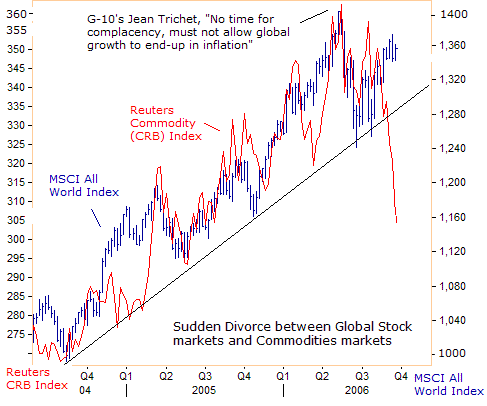 So what major outside forces knocked the “Commodity Super Cycle” off its upward course, and then led to the latest plunge in the Reuters CRB index? According to the charts above, the CRB moved drastically out of alignment with the global stock markets! The CRB index is 16% off its 25-year highs, with the king-pin crude oil and gold markets 20% lower, the copper and zinc markets are off 17% to 19%, yet the global stock markets were left unscathed. Is the latest down-turn in the industrial commodities signaling the onset of a global economic recession, led by a US housing slump or a hard landing in China, and not yet reflected in the global stock markets? Or did the rout in the Reuters Commodity index simply wipe out a swath of speculative froth after a four-year climb, a classic shake-out of over-extended long positions, and presenting bargain hunters with new opportunities to make money in a longer-term secular bull market? The major forces that have rattled the Reuters CRB index within such a short period of time, to its lowest level in a year and a half include, (1) Global central bankers are lifting interest rates in unison, and slowly draining global liquidity. (2) Beijing is tightening its grip on the yuan money supply, leading to exaggerated fears of a hard landing for China's economy. (3) Crude oil traders unwound a $15 per barrel Iranian “war premium” after Europe's big-3 signaled a split from the Bush administration's campaign for UN economic sanctions against Iran. (4) Weaker crude oil prices triggered a rout in the gold and silver markets. Central Bankers Unite in Battle against the “Commodity Super Cycle” Coincidentally, the peak in the historic CRB index rally was recorded just three days after a May 8 th meeting of central bankers from leading industrialized and developing countries in Basel, Switzerland. Jean-Claude Trichet, spokesman for the G-10 group of central bankers, urged members to avoid complacency, because inflationary expectations were rising during a period of high commodity and energy prices. “It is not the time for complacency if we want this global growth to be sustainable. We have to be careful to see that this period of global growth does not end up in inflation. Global economic growth remains strong and steady, but there are elements there that call for very special attention, especially in terms of inflationary risks. We have to look at the inflationary risks with great attention,” Trichet declared.
So what major outside forces knocked the “Commodity Super Cycle” off its upward course, and then led to the latest plunge in the Reuters CRB index? According to the charts above, the CRB moved drastically out of alignment with the global stock markets! The CRB index is 16% off its 25-year highs, with the king-pin crude oil and gold markets 20% lower, the copper and zinc markets are off 17% to 19%, yet the global stock markets were left unscathed. Is the latest down-turn in the industrial commodities signaling the onset of a global economic recession, led by a US housing slump or a hard landing in China, and not yet reflected in the global stock markets? Or did the rout in the Reuters Commodity index simply wipe out a swath of speculative froth after a four-year climb, a classic shake-out of over-extended long positions, and presenting bargain hunters with new opportunities to make money in a longer-term secular bull market? The major forces that have rattled the Reuters CRB index within such a short period of time, to its lowest level in a year and a half include, (1) Global central bankers are lifting interest rates in unison, and slowly draining global liquidity. (2) Beijing is tightening its grip on the yuan money supply, leading to exaggerated fears of a hard landing for China's economy. (3) Crude oil traders unwound a $15 per barrel Iranian “war premium” after Europe's big-3 signaled a split from the Bush administration's campaign for UN economic sanctions against Iran. (4) Weaker crude oil prices triggered a rout in the gold and silver markets. Central Bankers Unite in Battle against the “Commodity Super Cycle” Coincidentally, the peak in the historic CRB index rally was recorded just three days after a May 8 th meeting of central bankers from leading industrialized and developing countries in Basel, Switzerland. Jean-Claude Trichet, spokesman for the G-10 group of central bankers, urged members to avoid complacency, because inflationary expectations were rising during a period of high commodity and energy prices. “It is not the time for complacency if we want this global growth to be sustainable. We have to be careful to see that this period of global growth does not end up in inflation. Global economic growth remains strong and steady, but there are elements there that call for very special attention, especially in terms of inflationary risks. We have to look at the inflationary risks with great attention,” Trichet declared.
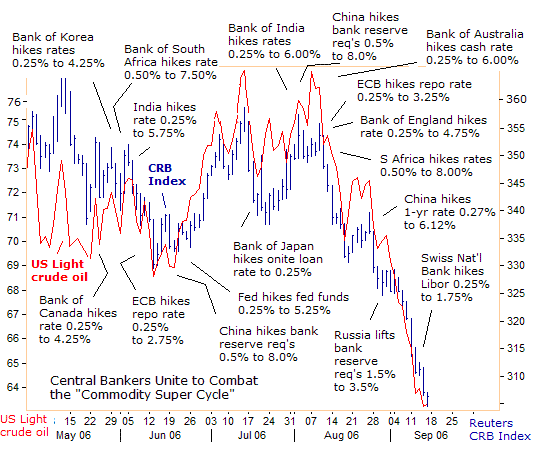
Central bankers from a dozen different countries heeded Trichet's siren call to tighten their money spigots, including emerging market giants in China, India, and Russia. A barrage of quarter-point rate hikes by a united front of central banks, and higher bank reserves requirements in China and Russia, started to flatten out the Reuters CRB index in June - July, and then greased the skids for its biggest downfall in 16-years, in August and early September, led by a $15 /barrel slide in crude oil. The historic slide in the Reuters CRB took place since August 8 th , even after three major players, the Federal Reserve, the Bank of Canada, and the Bank of Korea ran out of ammunition, and the Bank of Japan was handcuffed by the ruling LDP party. But other central bankers picked up the slack in the battle against the “Commodity Super Cycle”, led by China and the ECB. Higher interest rates are still on tap for Australia, China, the Euro-zone, England, India, South Africa, and Switzerland in the months ahead, to keep commodity traders on edge.
The Bank of Japan's heavy hand For five long years, the Bank of Japan pegged its overnight loan rate at zero percent, and flooded local bank reserves with 30-35 trillion yen ($253-296 billion) of excess cash, around five to six times legally required levels. Cheap money in Tokyo spawned the “yen carry” trade, enabling speculators to borrow yen at zero percent to finance purchases of commodities, equities, emerging bonds, gold, etc. The Bank of Int'l Settlements said that in the seven quarters to the end of 2005, yen-denominated claims surged by $161 billion, with three quarters of this lending channeled to international financial centers such as the United Kingdom, Singapore, and the Cayman Islands, a favorite haven for hedge funds.
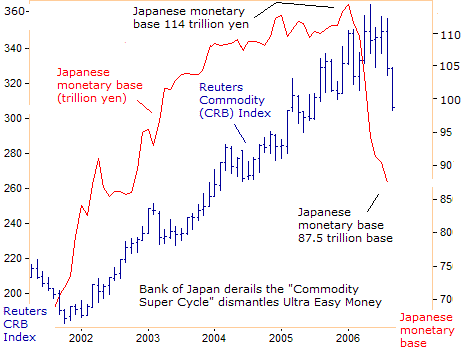
But on March 9 th , the BOJ signaled the end of its radical monetary policy called “quantitative easing” and moved quickly to drain liquidity out of the Tokyo money markets. By the time the Reuters CRB Index had reached its peak on May 11 th , the BOJ had already withdrawn 16 trillion yen from local banks. By the end of August, Japan's monetary base, money in circulation plus bank deposits, had fallen by 26.5 trillion yen since March 9 th , leading to further unwinding of the yen carry trade. The BOJ raised rates on July 14 th , for the first time in six years, to 0.25% from zero. But Kozo Yamamoto, the Liberal Democratic Party panel chief, argued the rate hike was premature in view of the fudged downward revision in Japan's consumer price index for 2006, and pointed to lingering risks of deflation. “They should think about additional rate cuts rather than additional rate hikes,” said Yamamoto, concerned by a possible deterioration in the Japanese economy. Federal Reserve finds the “Neutral Rate” Because most internationally traded commodities are traded in US dollars, the Federal Reserve has a special role to play in containing global inflation. The Fed got off to a slow start, but reversed course in June 2004, with a baby-step rate hike campaign in June 2004, that ultimately peaked two years later at 5.25 percent. The Fed's rate increases were usually telegraphed in advance, but its August 8 th decision to pause the 2-year campaign at 5.25%, is now looking like sheer brilliance. The Fed tracked the Reuters CRB index with a string of 17 consecutive rate hikes to 5.25%, but with central banks in Asia and Europe pursuing ultra-easy money policies, the job of getting ahead of the commodity inflation curve was much tougher. Once central banks in China, the Euro-zone, Japan, and India joined in the tightening campaign in 2006, the Fed's job was done.
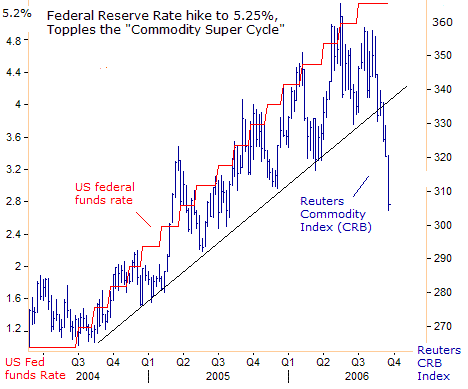
On Sept 8th , Cleveland Fed chief Sandra Pianalto signaled a steady monetary policy in the months ahead. 'We have to be vigilant with regards to inflation because we are the only ones who control it, but it requires judgment. It's always difficult to know where the appropriate resting place is for monetary policy. Monetary policy works with a lag. At this point, we've had 17 consecutive rate increases, and as our minutes show, we recognize that the full impact of those 17 consecutive rate increases have not been fully felt in the economy,' she said. But in the aftermath of the severe collapse of the CRB index below its key upward sloping trend-line, it doesn't take an expensive college education to figure that after a few more months of a steady hand, the Fed's next shift would probably be towards lower interest rates. US housing stocks rose by 10% last week, despite grim news on new and existing home sales, on expectations of easier money in 2007.
European Central Bank Brings Up the Rear Guard Since taking the helm of the European Central Bank in 2003, Jean “Tricky” Trichet pursued a super-easy money policy, allowing the Euro M3 money supply to expand an annualized 8.9% in May, pumping up European equity markets, and insulating them from oil price shocks. However, on July 19 th , Trichet signaled a new policy that takes commodity prices into account when deciding on Euro zone interest rates. “High oil and commodity prices demand close attention, and should not be ignored when measuring true inflation levels in the Euro zone,” Trichet argued. “The phenomenon we are observing is very important and we have to understand it. We are in some kind of supply shock but also a demand shock with the emergence of new giants. It certainly also calls for great attention on our part," he added. Industrial producer prices in the Euro zone are rising quickly outside the energy sector, reinforcing the ECB's sudden hawkish-ness. Euro-zone producer prices gained 0.6% in July from June for an annual rise of 5.9 percent. Excluding energy, producer price inflation accelerated to 3.4% in July, it's fastest rate since November 1995. The ECB left its main rate unchanged at 3% last week, but left little doubt that it planned to hike rates for a fifth time in October. European politicians worry that too much credit tightening could snuff out the best Euro-zone growth in six years, just as the region has emerged out of a long slumber. But ECB members Errki Liikanen of Finland and Yves Mersch of Luxembourg said that the ECB's focus must remain firmly on tackling inflationary pressures. "We need to guarantee that inflationary expectations will be solidly anchored, and that is why we also need to act. If the current economic scenario is confirmed, we need to continue the withdrawal of monetary accommodation," said Liikanen. The ECB "will exercise the greatest vigilance, not just in the immediate future, but you should also expect that the ECB won't have lost its imagination at the end of the year. We would not quarrel with market analysts' as they see the present and immediate next steps of the ECB,” Mersch added.
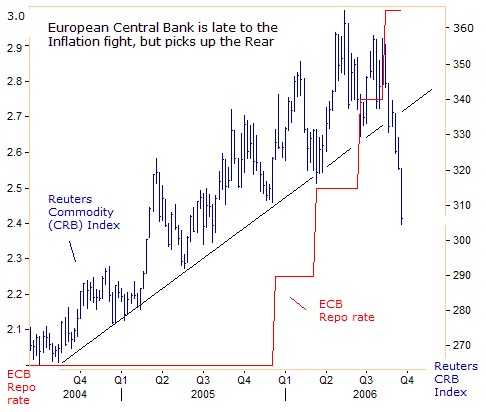
The ECB was very late to join the inflation fight, and waited until the Reuters CRB index had eclipsed the 320-mark, before lifting its repo rate from a 50-year low of 2.00% to 2.25% in December 2005. Now with the Fed and the BoJ sidelined, the ECB becomes the hatchet-man to combat the “Commodity Super Cycle” with a few more residual rate hikes in the months ahead. Futures markets in Frankfurt project three more ECB rate hikes to 3.75% by March 2007. When asked on Sept 7 th , whether ECB rates could go into restrictive territory to control inflation, a level usually viewed as rates above 3.5% that could start biting into growth, the ECB's Liikanen commented, 'We must be free to discuss that when we get there. We will act when we need to act. Nothing is closed and nothing is open. The commitment is to price stability.'
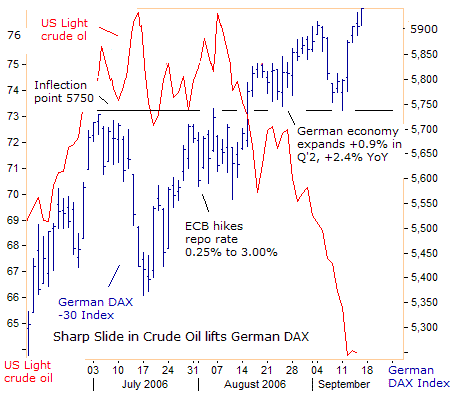
The ECB is in a sweet spot, with the stimulus of sharply lower oil prices offsetting the impact of a higher repo rate. Since the ECB's last rate hike to 3.00% on August 3 rd , the German DAX index has climbed 6% towards the psychological 6,000 level, aided by a $13 per barrel plunge in crude oil prices. Germany's crude oil import bill in the twelve months to July 2006 totaled 42.0 billion Euros ($53.94 billion), or 42.4% more than the 29.5 billion Euros paid in the same period a year earlier. Lower oil prices would put more Euros in the pockets of German consumers.
The Chinese Wildcard China's economy grew by an annual average 9.5% over the past three years, to overtake France and the UK to become the world's fourth largest. But despite the torrid growth, the living standards of China's 1.3 billion people are greatly unbalanced, where per capita income ranks 129 th in the world, lower than Egypt and Iran. Therefore, China's leaders have been strongly opposed to any stringent measures that could slow the economy down to less than 10% growth. China's economy requires 7% growth to breakeven with the number of new workers entering the job market each year. China has been riding a boom in exports and fixed-asset investment for the past four years, and repeatedly defied expectations of a slowdown. However, the juggernaut Chinese economy could slow to single digit growth, if the People's Bank of China (PBoC) tightening steps begin to bite, and the huge trade surplus dips in response to slowing US growth. The PBoC prints huge sums of yuan to hold down the currency's exchange rate, and in the process is fuelling the boom in investment and credit, and overheating its economy. The cheap yuan enabled China to chalk up a trade surplus of $18.8 billion in August, the fourth consecutive monthly record, and its foreign exchange reserves soared to $954.5 billion. The cumulative trade surplus for the first eight months was $94.65 billion, nearly 60% more than in the same period last year.
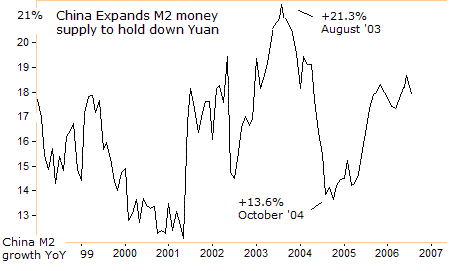
To get a grip on M2 money supply, growing at a 17.9% annualized rate in August, the PBoC has raised lending rates twice since late April and ordered a 1% increase in the proportion of deposits that local banks must hold in reserve instead of lending out. The higher bank reserve requirements have tied up 300 billion yuan, but have not restrained credit growth nor the economy, which expanded at an 11.3% clip in Q'2, it's fastest in a decade. But on Sept 10 th , PBoC chief Zhou Xiaochuan said the 11.3% annual growth was “a little bit too high, and there are several macro-economic adjustments to slow it down a bit. Liquidity is still abundant in the Chinese economy so we are going to squeeze the liquidity. There are several ways, we can either expand the operation on open markets, we could once again use reserve requirements, it's flexible,” he said.
“China's priority for the rest of the year is to rein in capital spending and it will rely more on monetary policy measures, rather than administrative curbs, to do so,” warned Vice Premier Zeng Peiyan on the same day as Zhou. “The priority for the second half is to control the over-rapid increase in fixed-asset investment. We will try to rely less on administrative measures and mainly use economic and legal measures in our macro controls,” Zeng declared.
“That includes appropriately adjusting money supply and credit and taking comprehensive measures to mop up liquidity in the banking system. We will also improve the formation mechanism of the yuan's exchange rate.” Two days later, the People's Bank of China backed up its tough talk with action by mopping up a record 225 billion yuan ($28.3 billion) in its open market operations on Sept 12 th . That was nearly double the 120 yuan withdrawn from banks by the PBoC on July 12 th .
Chinese Economy is Engine of Growth in Asia In the event that the PBoC tips the economy towards 7-8% growth, as the latest downturn in commodity markets and Australian mining shares suggest, then the tremors would ripple through-out Asia. A sharp slowdown in the US economy, linked to a downturn in the housing market, is also a risk to China's economy, where exports amounted to 40% of its GDP, compared with about 25% in France and 10% for Japan.
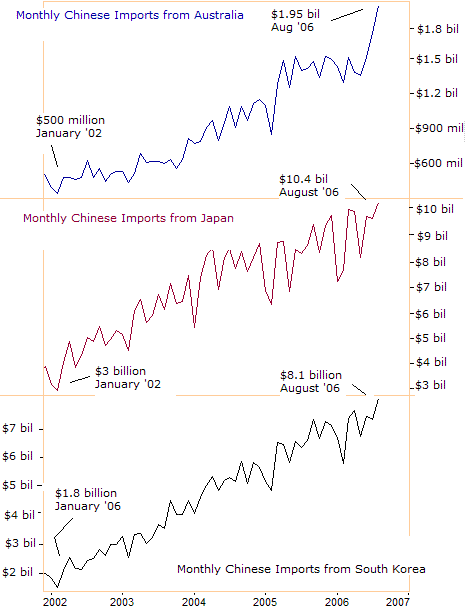
In August, Chinese imports jumped to a record $72 billion, a stunning 24.6% higher from a year earlier. Therefore, any sharp slowdown in the Chinese economy would also be felt by neighboring exporters in Australia, Japan, and South Korea, whose sales to China are at all-time record highs. Already, Korean exports to China, which grew in excess of 50% during 2004 and into 2005, have slowed to a pace of 12% in the first half of 2006. China accounts for more than 20% of Korea's foreign sales. Japanese exports to China expanded 26.1% to a record 4.9 trillion yen in the first half of 2006. Growth in Australian exports to China has averaged 19% annually for the past five years. According to the IMF, the China is also the main engine of growth for economies in Hong Kong, Indonesia, the Philippines, Singapore and Thailand given their strong intraregional trade ties. But on Sept 18 th , Qiu Xiaohua, commissioner of the Chinese National Bureau of Statistics, said Beijing should aim to achieve annual economic growth of between 7% and 8% to keep output on a sustainable path. “Judging from constraints upon capital and energy supplies, an average annual GDP growth rate of 7-8% is manageable, but a growth rate of 9% is not,” he concluded. “Growth of 9% would create massive oil supply shortages and lead to such rapid expansion in investment that it would warp the economic structure and make it difficult to sustain growth. Annual growth of anything beyond 9% would probably lead to an inflation rate of greater than 5%,” Xiaohua said.
Australian Miners Rattled by fears of Chinese Slowdown Exaggerated fears of a hard landing for the Chinese economy were evident in mining giants BHP Billiton and Rio Tinto last week. Australia's BHP Billiton, the world's biggest mining company, posted a 77% increase in second- half profit, to $6.1 billion on August 23 rd . Sales to China jumped 50% to $3.6 billion in the second-half from a year ago. Yet BHP shares have tumbled by 10% since reporting its stellar earnings.
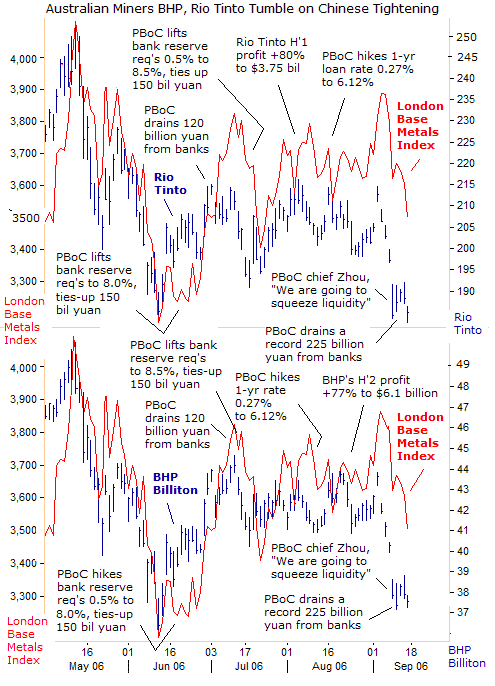
Rio Tinto, the world's second-largest mining firm, posted a better-than-expected 80% leap in first-half profit on strong demand for minerals world-wide. Half-year underlying net profit rose to $3.75 billion from $2.09 billion a year earlier, China accounted for 14% of the company's $10.6 billion in sales. Copper made the single biggest contribution to Rio's bottom line, generating $2.79 billion in earnings before EBITDA, followed by iron ore, which accounted for $1.66 billion. Yet Rio Tinto shares are 12% lower since reporting its stellar results, on uncertainty over China.
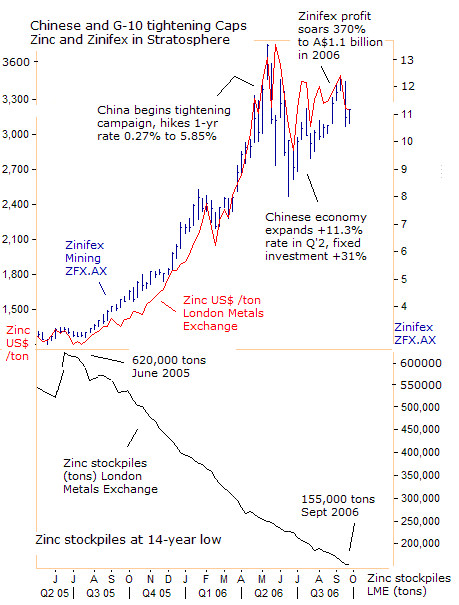
Australia's Zinifex Mining, ZFX.AX, the world's second largest zinc miner, topped out on May 12 th at A$13.54 /share, after the PBoC and G-10 central bankers kicked off their mini tightening campaign. China is the world's biggest consumer of zinc at 3.08 million tons in 2005. On August 24 th , Zinifex said its fiscal 2006 profit soared to A$1.08 billion from A$231.6 million a year earlier, and paid a final dividend of 70 cents a share, up from 4 cents a share a year ago. Zinc tripled to a record high of $4,000 per ton on May 11 th , but has since settled around $3,230 per ton, off 19.2% from its all-time high. Every 1% change in the zinc price is worth about A$14 million to Zinifex's bottom line. “If zinc prices over the course of 2006/07 continue at similar levels, then increased revenue will more than offset expected cost escalation and we would anticipate another excellent year for Zinifex,” the company said. However, Zinc will be a very tough nut too crack, with London stockpiles dwindling to 155,000 tons, or 75% lower since June 2005.
Unwinding the $15 per barrel Iranian ‘War premium” The most influential driver behind the CRB's plunge since August 8 th however, was the unwinding of the Iranian “war premium” which had inflated the price of crude oil by as much as $15 per barrel this year. Iranian negotiators have skillfully split the British, French and the German coalition away from the Bush administration's hard-line stance for economic sanctions against Iran. Iran's rulers have always relied on the Russian and Chinese veto to any economic sanctions, but now there are signs the Europeans are also seeking a way out, once the moment of truth had finally arrived. On Sept 13 th , British Foreign office minister Kim Howells waved the white flag, “I can't see a military way through this, and I'm not sure that even there's an easy way for the UN to impose sanctions," he told parliament's Foreign Affairs Committee. Economic sanctions against Iran would jeopardize more than 10,000 jobs, the German Chamber of Commerce said on Sept 1 st . “Economic sanctions against Iran would solve none of the political problems. But the German economy would be hard hit in an important growing market.” France's oil giant Total is interested in a 10-15% stake in Iran's Azadegan, seen as one of the largest unexploited oilfields in the world, said head of exploration Christophe de Margerie on Sept 12 th . On Sept 18 th , Norwegian energy and aluminum giant Norsk Hydro, signed an oil exploration deal with the National Iranian Oil Company for the Khorramabad block in southwestern Iran. “If exploration proves to be successful, the period of the agreement will be 25 years,” Hydro said. Iran's chief nuclear negotiator Ali Larijani reportedly offered a 2-month suspension of Tehran's nuclear enrichment program in talks with EU foreign policy chief Javier Solana, which sent crude oil plunging below $66 per barrel. Still, there are questions of whether or not Iran's internal debate is over, and if the concession by Larijani is fully backed by the Ayatollah Khameinei and president Amadinejad in Tehran.
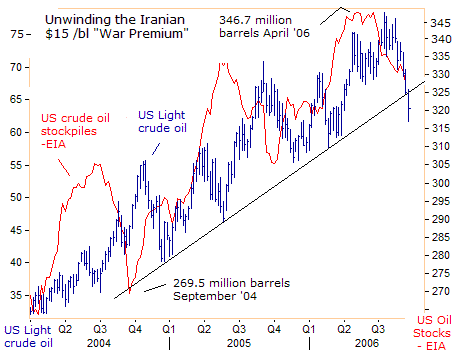
Without the imposition of UN sanctions or the threat of military action against Iran, crude oil succumbed to the laws of supply and demand. US stockpiles of crude oil were 327.7 million barrels last week, or 18% higher from two years ago, when crude oil was trading at $45 per barrel. Unleaded gasoline prices tumbled 65 cents a gallon since August 1 st , and boosted US President George Bush's approval ratings by 3% to 41% last week, with seven weeks left before mid-term US elections in Congress. 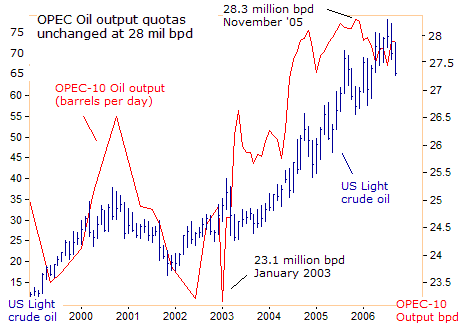
OPEC, which supplies 40% of the world's oil, has been pumping 28 million barrels per day (bpd), since November 2004, when crude oil first touched a record $50 per barrel, but was unable to stop the surge in crude oil to a record $78.40 /bl in July 2006. But with a bearish market mood and unwinding of the Iranian “war premium”, crude oil traders seized upon OPEC's Sept 11 th pledge to leave its output unchanged at 28 mil bpd, and dumped oil to as low as $62 per barrel on Sept 15 th . Crude oil traders are beginning to view the Bush team as a paper tiger in dealing with Iran. Other traders think the gloves will come off after the US Congressional elections on November 7 th , when whispers of a US military adventure could grow louder. In any case, China's crude oil imports rebounded 15% to 11.8 million tons in August, which could put a floor under the market at $60 /barrel.
Gold Tumbles Under $600 /oz Gold tumbled under $600 per ounce last week, in line with a weaker crude oil and CRB index, telegraphing lower headline inflation in G-7 oil importing countries in the months ahead. Gold has also been pressured by fears of by European central bank sales ahead of a Sept 26 th fiscal year-end that limits sales to 500 tons per year. So far, European central banks have only sold an estimated 340 to 360 tons this year.
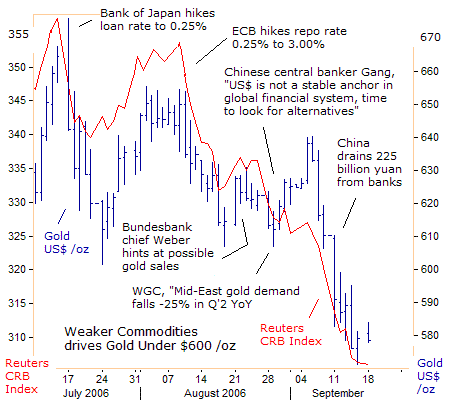
With central bankers coordinating their tightening moves, there has been little volatility in the foreign exchange markets to influence the price of gold. Instead, gold traders are focusing on crude oil and other key industrial commodities for clues about the future direction of inflation. Supporting the gold market however, is speculation of eventual Chinese central bank diversification into gold. Only 1% of China's $954 billion of foreign currency reserves are held in the yellow metal. The US current account, the broadest measure of trade with the rest of the world, includes both trade in goods and investment flows, widened in the second quarter to $218.4 billion, and remains a major risk for the global economy. The US deficit totaled 6.6% of gross domestic output, the same as in the first quarter. That compares with China's current account surplus of 7% of GDP. With pressure mounting on Beijing to revalue it yuan upwards, China could quietly build a gold position in a declining market. Fan Gang, a member of China's central bank monetary policy committee said on August 29 th , "The US dollar is no longer a stable anchor in the global financial system, nor is it likely to become one, therefore it is time to look for alternatives.”
Is Canadian Petro-dollar at Risk?
Robust base metals and energy prices, which draw investment to Canada's resource-heavy stock market, have been key factors behind the Canadian dollar's 40% rise against the US dollar over the past four years. But commodity and oil prices have turned south and the CD$ has yet to fully adjust. Capital flows could reverse if there's an exodus from Canada's oil and gold sector, which make up 50% of the Toronto Stock Exchange.
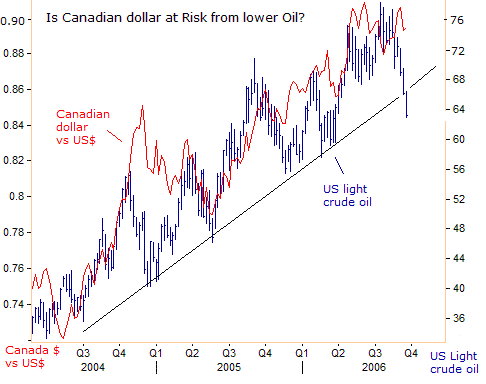
Furthermore, Canada lost 16,000 jobs in August, the third consecutive monthly loss, suggesting that the Bank of Canada's rate hike campaign has peaked at 4.25%, and rates might be too high. However, any BoC rate cuts would probably be coordinated with the Federal Reserve, which could start cutting rates in 2007 to defend US home prices from falling, to engineer a “soft landing” for the US economy.
** If you enjoyed this article, consider a subscription to the Global Money Trends newsletter published on the 1 st and 15 th of each month in pdf format, and 20-25 pages in length. GMT collects a wide array of news and information from reputable sources, filters out the noise and distractions, and puts all the pieces of global economic puzzle together into coherent snapshot analyses, with lots of cool charts depicting the inter-relationships of markets and economies around the world. Here's what you will receive with a subscription, Insightful analysis and predictions of, (1) top stock market indexes around the world, and US-listed Exchange Traded Funds (ETF's) and closed-end country funds. (2) Commodities such as crude oil, copper, gold, silver, the CRB index, and gold mining and oil company indexes. (3) Foreign currencies such as, the Australian dollar, British pound, Euro, Japanese yen, and Canadian dollar. ($) Libor interest rates, global bond markets and their central bank monetary policies. A subscription to Global Money Trends is $110 US dollars per year for 24 issues, including access to all back issues. Click on the following hyperlink, to order now, http://www.sirchartsalot.com/newsletters.php This article may be re-printed in its entirety on other internet sites for public viewing, with links to, http://www.sirchartsalot.com/newsletters.php Disclaimer: SirChartsAlot.com's analysis and insights are based upon data gathered by it from various sources believed to be reliable, complete and accurate. However, no guarantee is made by SirChartsAlot.com as to the reliability, completeness and accuracy of the data so analyzed. SirChartsAlot.com is in the business of gathering information, analyzing it and disseminating the analysis for informational and educational purposes only. SirChartsAlot.com attempts to analyze trends, not make recommendations. All statements and expressions are the opinion of SirChartsAlot.com and are not meant to be investment advice or solicitation or recommendation to establish market positions. Our opinions are subject to change without notice. SirChartsAlot.com strongly advises readers to conduct thorough research relevant to decisions and verify facts from various independent sources.
© 2005-2022 http://www.MarketOracle.co.uk - The Market Oracle is a FREE Daily Financial Markets Analysis & Forecasting online publication.



